Taxation Law Report: Case Studies on Income and Trading Stock
VerifiedAdded on 2021/06/16
|13
|3469
|16
Report
AI Summary
This report provides a comprehensive analysis of taxation law principles, specifically focusing on the assessment of income and the treatment of trading stock, using the case of Arthur Murray (NSW) Pty Ltd v FCT as a key example. The report delves into the application of Section 6-5 of the ITAA 1997, examining different methods for calculating business income, such as the earnings and receipts methods, and determining the appropriate method for assessing income. The report also examines the case of RIP Pty Ltd, a funeral service company, to illustrate how the principles established in the Arthur Murray case apply to advance payments and income recognition. It explores the implications of advance payments, forfeited payments, and the treatment of trading stock, including caskets and accessories. Furthermore, the report references relevant sections of the ITAA 1997, such as Section 70-10 and 70-25, to clarify the definition and treatment of trading stock. Finally, the report addresses the tax implications of forfeited payments in the context of RIP Pty Ltd's easy funeral scheme. The analysis provides insights into income tax assessment, tax principles, and the application of tax law in practical business scenarios.
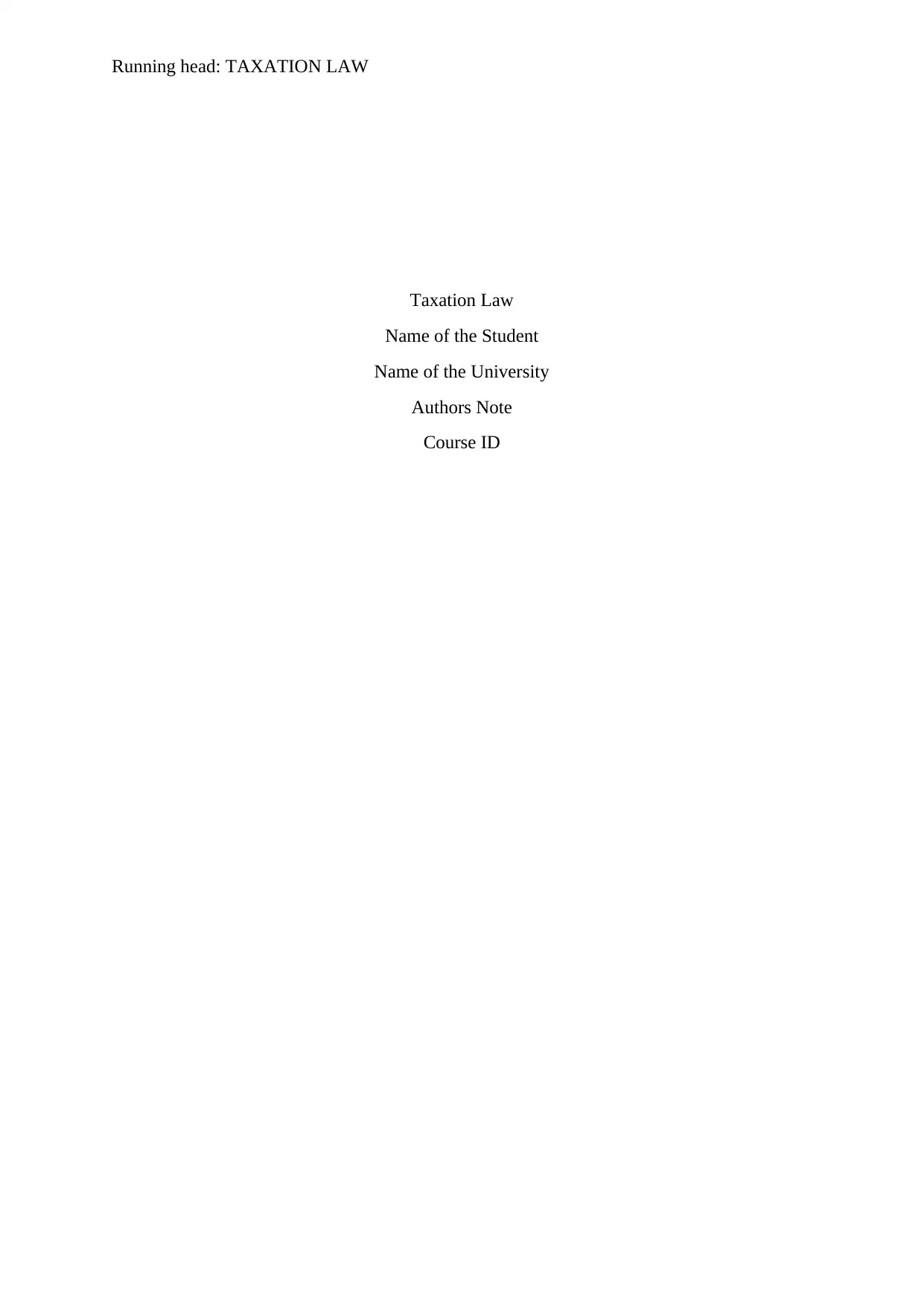
Running head: TAXATION LAW
Taxation Law
Name of the Student
Name of the University
Authors Note
Course ID
Taxation Law
Name of the Student
Name of the University
Authors Note
Course ID
Paraphrase This Document
Need a fresh take? Get an instant paraphrase of this document with our AI Paraphraser
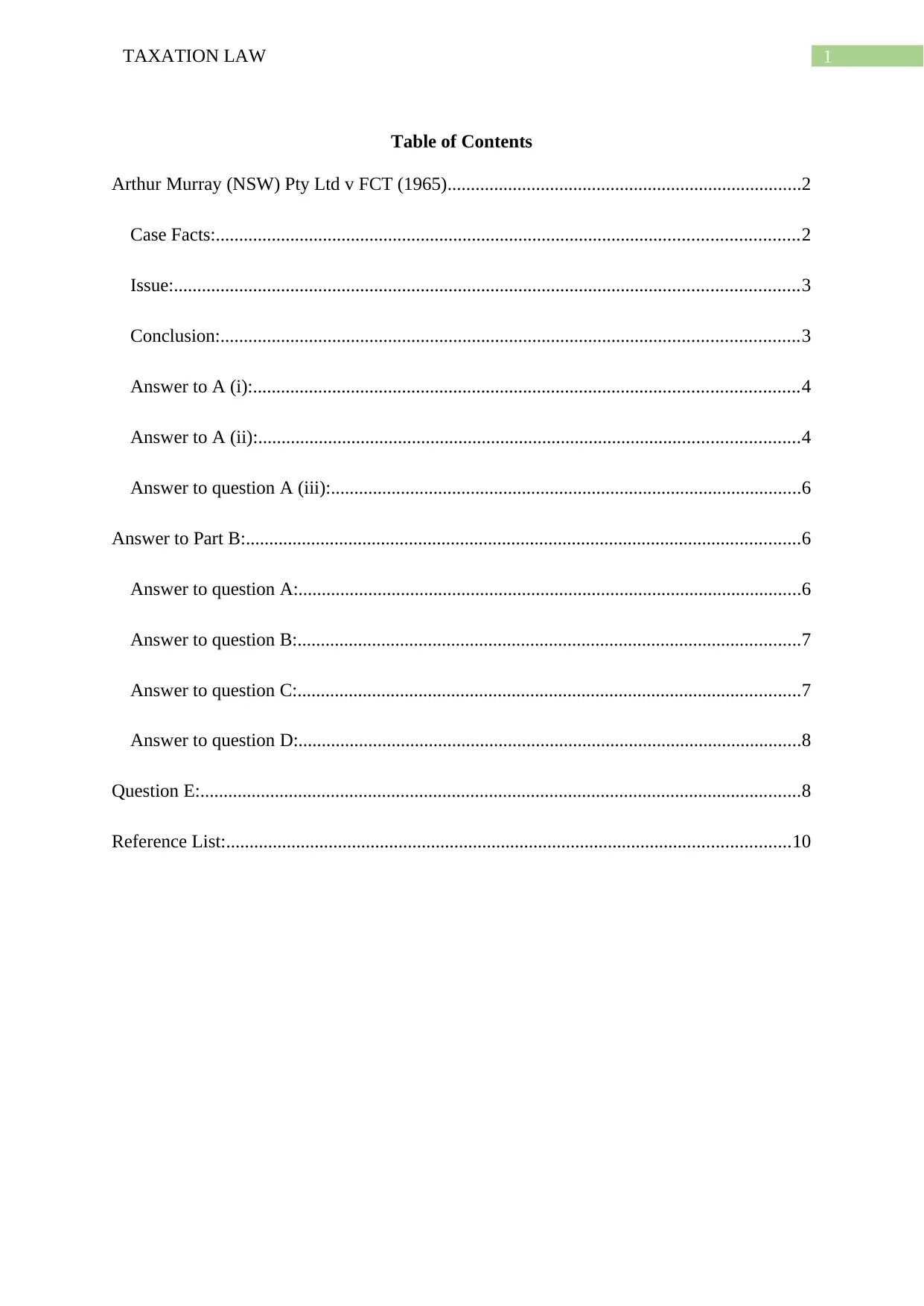
1TAXATION LAW
Table of Contents
Arthur Murray (NSW) Pty Ltd v FCT (1965)............................................................................2
Case Facts:.............................................................................................................................2
Issue:......................................................................................................................................3
Conclusion:............................................................................................................................3
Answer to A (i):.....................................................................................................................4
Answer to A (ii):....................................................................................................................4
Answer to question A (iii):.....................................................................................................6
Answer to Part B:.......................................................................................................................6
Answer to question A:............................................................................................................6
Answer to question B:............................................................................................................7
Answer to question C:............................................................................................................7
Answer to question D:............................................................................................................8
Question E:.................................................................................................................................8
Reference List:.........................................................................................................................10
Table of Contents
Arthur Murray (NSW) Pty Ltd v FCT (1965)............................................................................2
Case Facts:.............................................................................................................................2
Issue:......................................................................................................................................3
Conclusion:............................................................................................................................3
Answer to A (i):.....................................................................................................................4
Answer to A (ii):....................................................................................................................4
Answer to question A (iii):.....................................................................................................6
Answer to Part B:.......................................................................................................................6
Answer to question A:............................................................................................................6
Answer to question B:............................................................................................................7
Answer to question C:............................................................................................................7
Answer to question D:............................................................................................................8
Question E:.................................................................................................................................8
Reference List:.........................................................................................................................10
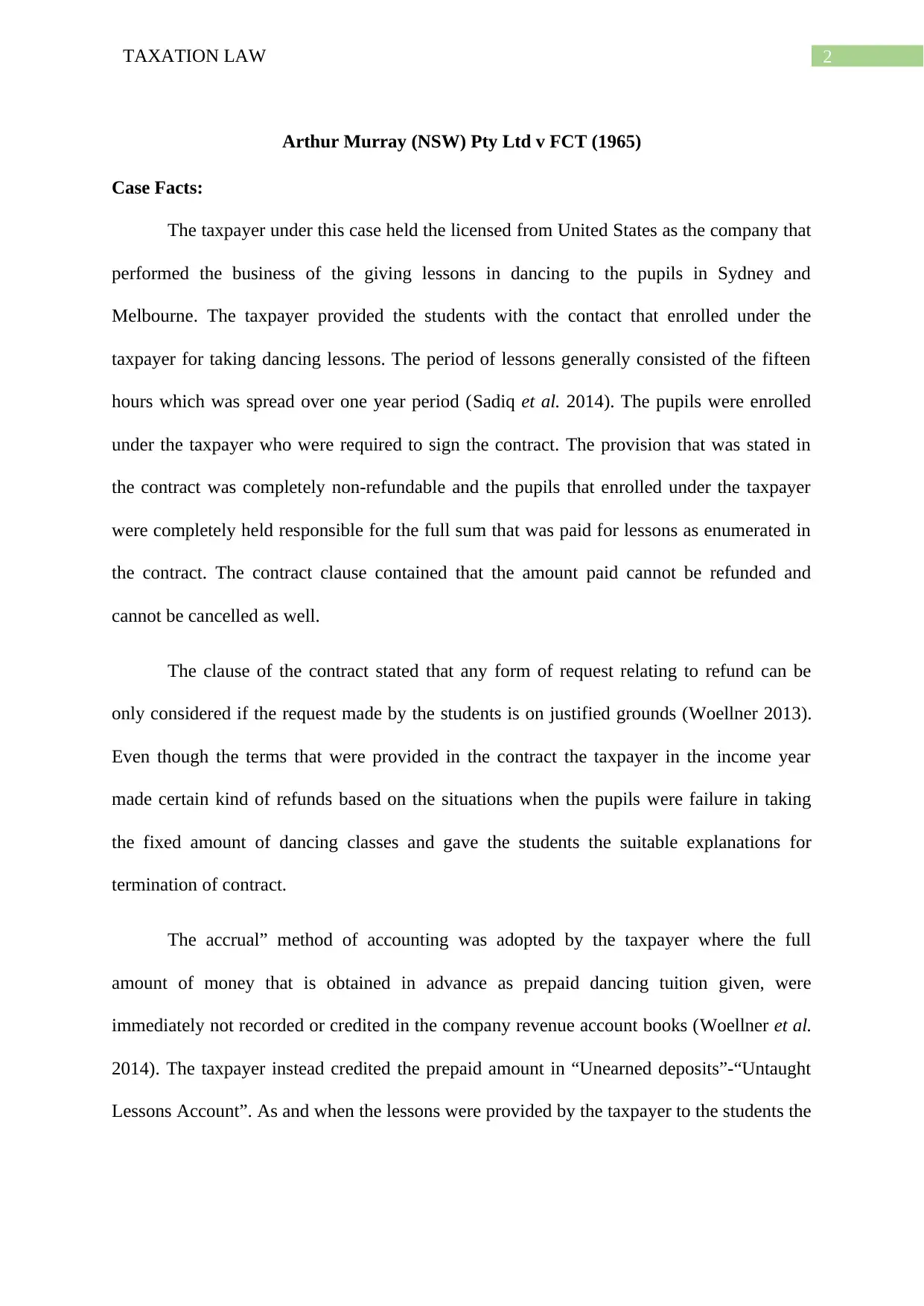
2TAXATION LAW
Arthur Murray (NSW) Pty Ltd v FCT (1965)
Case Facts:
The taxpayer under this case held the licensed from United States as the company that
performed the business of the giving lessons in dancing to the pupils in Sydney and
Melbourne. The taxpayer provided the students with the contact that enrolled under the
taxpayer for taking dancing lessons. The period of lessons generally consisted of the fifteen
hours which was spread over one year period (Sadiq et al. 2014). The pupils were enrolled
under the taxpayer who were required to sign the contract. The provision that was stated in
the contract was completely non-refundable and the pupils that enrolled under the taxpayer
were completely held responsible for the full sum that was paid for lessons as enumerated in
the contract. The contract clause contained that the amount paid cannot be refunded and
cannot be cancelled as well.
The clause of the contract stated that any form of request relating to refund can be
only considered if the request made by the students is on justified grounds (Woellner 2013).
Even though the terms that were provided in the contract the taxpayer in the income year
made certain kind of refunds based on the situations when the pupils were failure in taking
the fixed amount of dancing classes and gave the students the suitable explanations for
termination of contract.
The accrual” method of accounting was adopted by the taxpayer where the full
amount of money that is obtained in advance as prepaid dancing tuition given, were
immediately not recorded or credited in the company revenue account books (Woellner et al.
2014). The taxpayer instead credited the prepaid amount in “Unearned deposits”-“Untaught
Lessons Account”. As and when the lessons were provided by the taxpayer to the students the
Arthur Murray (NSW) Pty Ltd v FCT (1965)
Case Facts:
The taxpayer under this case held the licensed from United States as the company that
performed the business of the giving lessons in dancing to the pupils in Sydney and
Melbourne. The taxpayer provided the students with the contact that enrolled under the
taxpayer for taking dancing lessons. The period of lessons generally consisted of the fifteen
hours which was spread over one year period (Sadiq et al. 2014). The pupils were enrolled
under the taxpayer who were required to sign the contract. The provision that was stated in
the contract was completely non-refundable and the pupils that enrolled under the taxpayer
were completely held responsible for the full sum that was paid for lessons as enumerated in
the contract. The contract clause contained that the amount paid cannot be refunded and
cannot be cancelled as well.
The clause of the contract stated that any form of request relating to refund can be
only considered if the request made by the students is on justified grounds (Woellner 2013).
Even though the terms that were provided in the contract the taxpayer in the income year
made certain kind of refunds based on the situations when the pupils were failure in taking
the fixed amount of dancing classes and gave the students the suitable explanations for
termination of contract.
The accrual” method of accounting was adopted by the taxpayer where the full
amount of money that is obtained in advance as prepaid dancing tuition given, were
immediately not recorded or credited in the company revenue account books (Woellner et al.
2014). The taxpayer instead credited the prepaid amount in “Unearned deposits”-“Untaught
Lessons Account”. As and when the lessons were provided by the taxpayer to the students the
⊘ This is a preview!⊘
Do you want full access?
Subscribe today to unlock all pages.

Trusted by 1+ million students worldwide
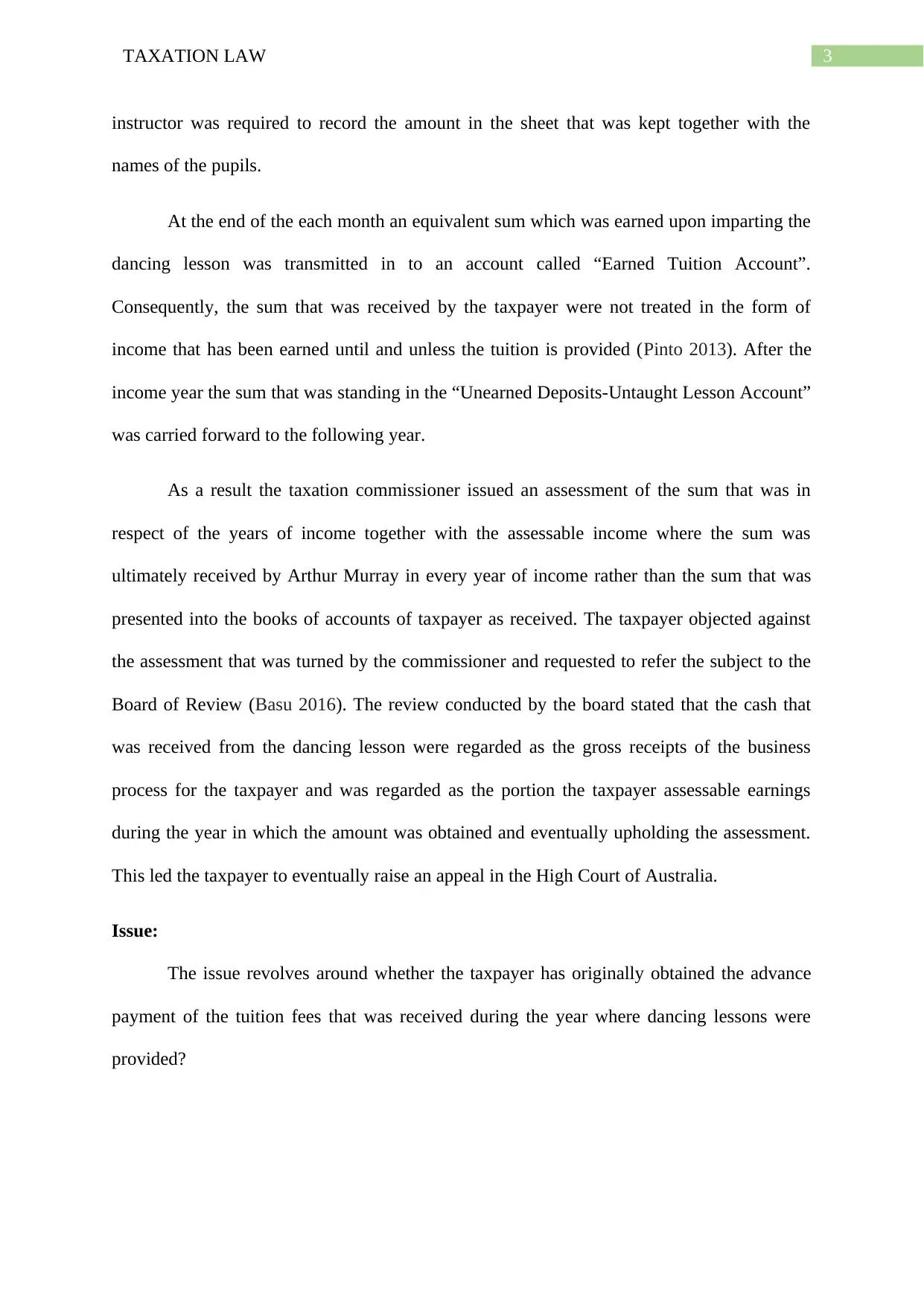
3TAXATION LAW
instructor was required to record the amount in the sheet that was kept together with the
names of the pupils.
At the end of the each month an equivalent sum which was earned upon imparting the
dancing lesson was transmitted in to an account called “Earned Tuition Account”.
Consequently, the sum that was received by the taxpayer were not treated in the form of
income that has been earned until and unless the tuition is provided (Pinto 2013). After the
income year the sum that was standing in the “Unearned Deposits-Untaught Lesson Account”
was carried forward to the following year.
As a result the taxation commissioner issued an assessment of the sum that was in
respect of the years of income together with the assessable income where the sum was
ultimately received by Arthur Murray in every year of income rather than the sum that was
presented into the books of accounts of taxpayer as received. The taxpayer objected against
the assessment that was turned by the commissioner and requested to refer the subject to the
Board of Review (Basu 2016). The review conducted by the board stated that the cash that
was received from the dancing lesson were regarded as the gross receipts of the business
process for the taxpayer and was regarded as the portion the taxpayer assessable earnings
during the year in which the amount was obtained and eventually upholding the assessment.
This led the taxpayer to eventually raise an appeal in the High Court of Australia.
Issue:
The issue revolves around whether the taxpayer has originally obtained the advance
payment of the tuition fees that was received during the year where dancing lessons were
provided?
instructor was required to record the amount in the sheet that was kept together with the
names of the pupils.
At the end of the each month an equivalent sum which was earned upon imparting the
dancing lesson was transmitted in to an account called “Earned Tuition Account”.
Consequently, the sum that was received by the taxpayer were not treated in the form of
income that has been earned until and unless the tuition is provided (Pinto 2013). After the
income year the sum that was standing in the “Unearned Deposits-Untaught Lesson Account”
was carried forward to the following year.
As a result the taxation commissioner issued an assessment of the sum that was in
respect of the years of income together with the assessable income where the sum was
ultimately received by Arthur Murray in every year of income rather than the sum that was
presented into the books of accounts of taxpayer as received. The taxpayer objected against
the assessment that was turned by the commissioner and requested to refer the subject to the
Board of Review (Basu 2016). The review conducted by the board stated that the cash that
was received from the dancing lesson were regarded as the gross receipts of the business
process for the taxpayer and was regarded as the portion the taxpayer assessable earnings
during the year in which the amount was obtained and eventually upholding the assessment.
This led the taxpayer to eventually raise an appeal in the High Court of Australia.
Issue:
The issue revolves around whether the taxpayer has originally obtained the advance
payment of the tuition fees that was received during the year where dancing lessons were
provided?
Paraphrase This Document
Need a fresh take? Get an instant paraphrase of this document with our AI Paraphraser
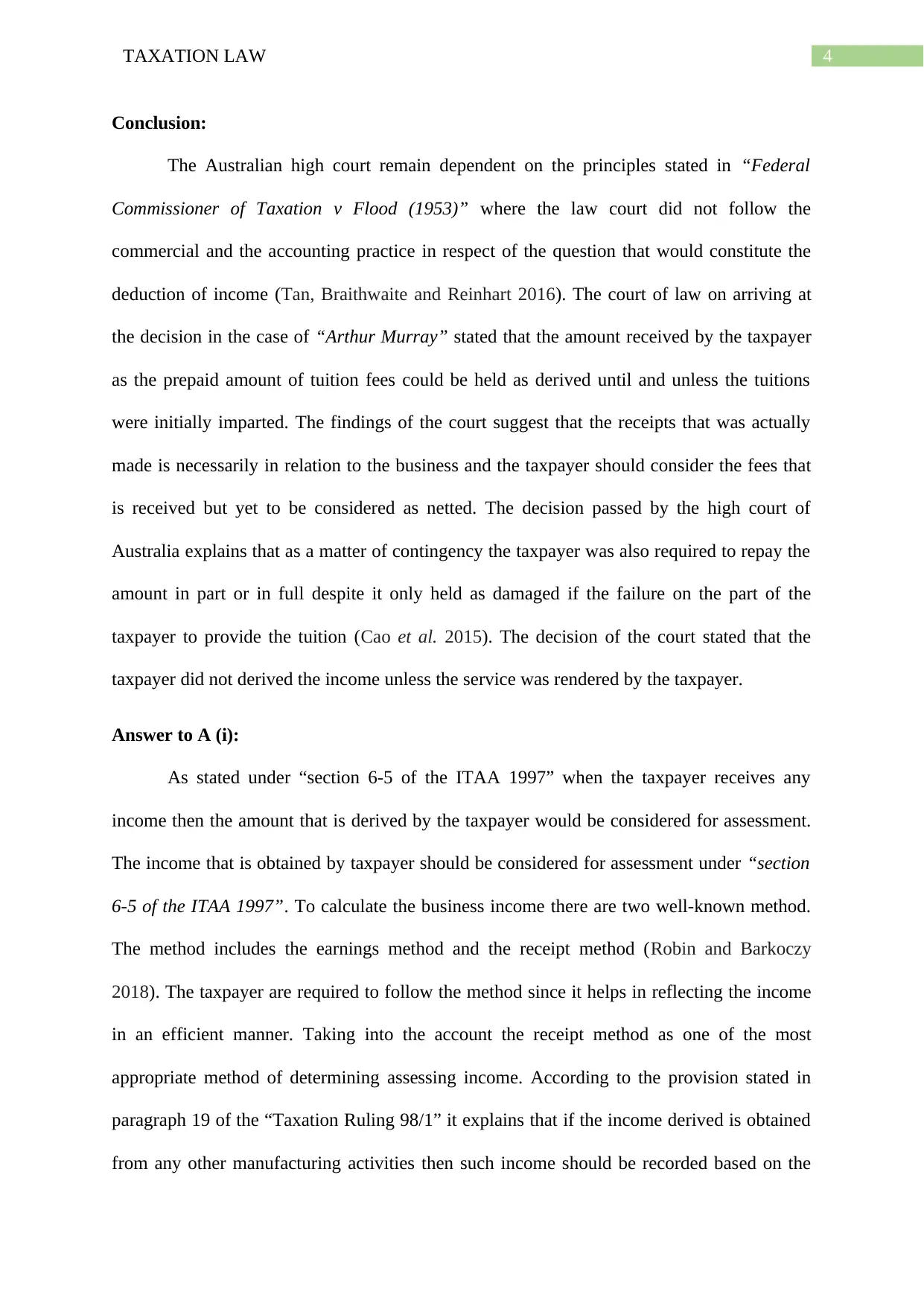
4TAXATION LAW
Conclusion:
The Australian high court remain dependent on the principles stated in “Federal
Commissioner of Taxation v Flood (1953)” where the law court did not follow the
commercial and the accounting practice in respect of the question that would constitute the
deduction of income (Tan, Braithwaite and Reinhart 2016). The court of law on arriving at
the decision in the case of “Arthur Murray” stated that the amount received by the taxpayer
as the prepaid amount of tuition fees could be held as derived until and unless the tuitions
were initially imparted. The findings of the court suggest that the receipts that was actually
made is necessarily in relation to the business and the taxpayer should consider the fees that
is received but yet to be considered as netted. The decision passed by the high court of
Australia explains that as a matter of contingency the taxpayer was also required to repay the
amount in part or in full despite it only held as damaged if the failure on the part of the
taxpayer to provide the tuition (Cao et al. 2015). The decision of the court stated that the
taxpayer did not derived the income unless the service was rendered by the taxpayer.
Answer to A (i):
As stated under “section 6-5 of the ITAA 1997” when the taxpayer receives any
income then the amount that is derived by the taxpayer would be considered for assessment.
The income that is obtained by taxpayer should be considered for assessment under “section
6-5 of the ITAA 1997”. To calculate the business income there are two well-known method.
The method includes the earnings method and the receipt method (Robin and Barkoczy
2018). The taxpayer are required to follow the method since it helps in reflecting the income
in an efficient manner. Taking into the account the receipt method as one of the most
appropriate method of determining assessing income. According to the provision stated in
paragraph 19 of the “Taxation Ruling 98/1” it explains that if the income derived is obtained
from any other manufacturing activities then such income should be recorded based on the
Conclusion:
The Australian high court remain dependent on the principles stated in “Federal
Commissioner of Taxation v Flood (1953)” where the law court did not follow the
commercial and the accounting practice in respect of the question that would constitute the
deduction of income (Tan, Braithwaite and Reinhart 2016). The court of law on arriving at
the decision in the case of “Arthur Murray” stated that the amount received by the taxpayer
as the prepaid amount of tuition fees could be held as derived until and unless the tuitions
were initially imparted. The findings of the court suggest that the receipts that was actually
made is necessarily in relation to the business and the taxpayer should consider the fees that
is received but yet to be considered as netted. The decision passed by the high court of
Australia explains that as a matter of contingency the taxpayer was also required to repay the
amount in part or in full despite it only held as damaged if the failure on the part of the
taxpayer to provide the tuition (Cao et al. 2015). The decision of the court stated that the
taxpayer did not derived the income unless the service was rendered by the taxpayer.
Answer to A (i):
As stated under “section 6-5 of the ITAA 1997” when the taxpayer receives any
income then the amount that is derived by the taxpayer would be considered for assessment.
The income that is obtained by taxpayer should be considered for assessment under “section
6-5 of the ITAA 1997”. To calculate the business income there are two well-known method.
The method includes the earnings method and the receipt method (Robin and Barkoczy
2018). The taxpayer are required to follow the method since it helps in reflecting the income
in an efficient manner. Taking into the account the receipt method as one of the most
appropriate method of determining assessing income. According to the provision stated in
paragraph 19 of the “Taxation Ruling 98/1” it explains that if the income derived is obtained
from any other manufacturing activities then such income should be recorded based on the
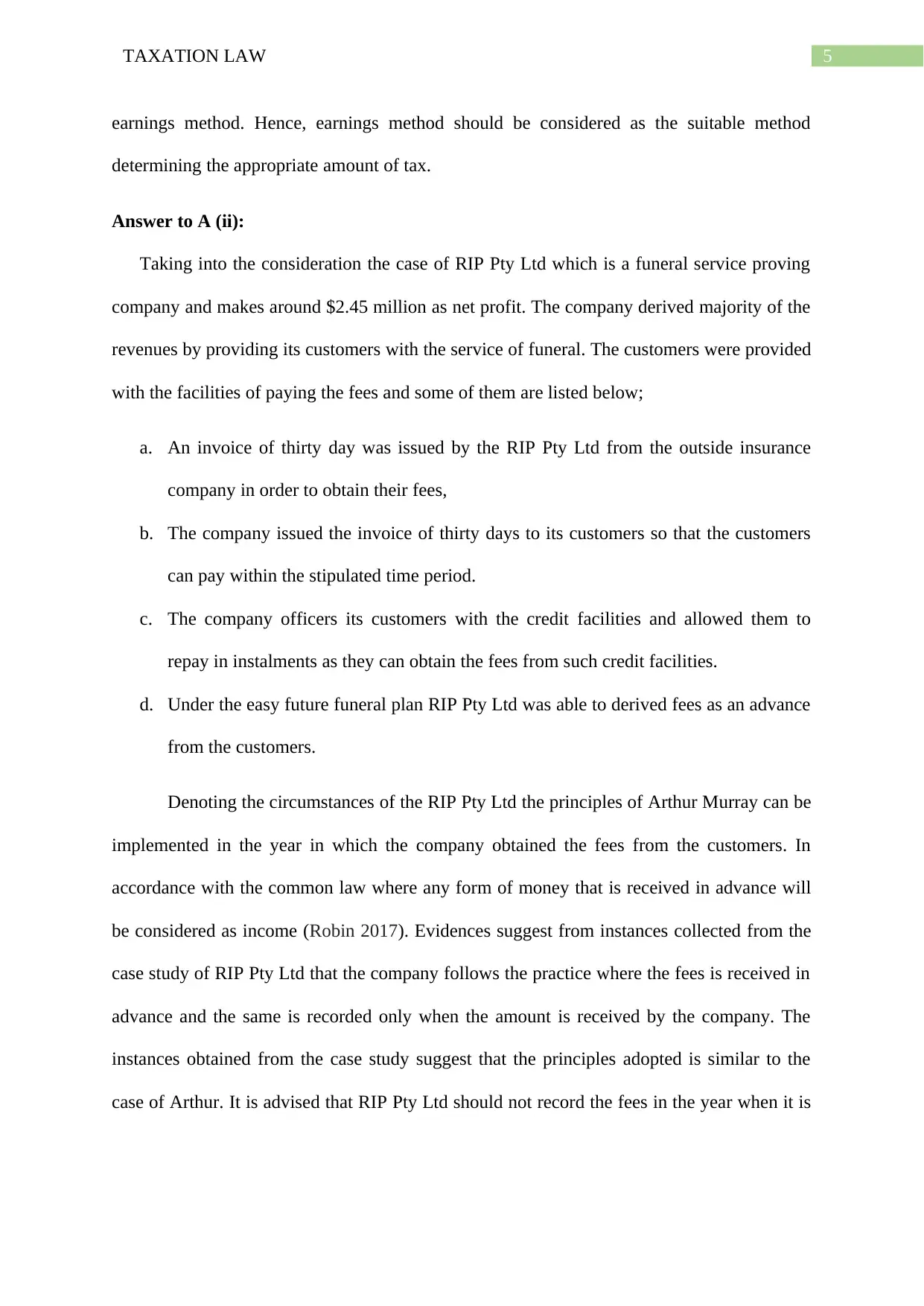
5TAXATION LAW
earnings method. Hence, earnings method should be considered as the suitable method
determining the appropriate amount of tax.
Answer to A (ii):
Taking into the consideration the case of RIP Pty Ltd which is a funeral service proving
company and makes around $2.45 million as net profit. The company derived majority of the
revenues by providing its customers with the service of funeral. The customers were provided
with the facilities of paying the fees and some of them are listed below;
a. An invoice of thirty day was issued by the RIP Pty Ltd from the outside insurance
company in order to obtain their fees,
b. The company issued the invoice of thirty days to its customers so that the customers
can pay within the stipulated time period.
c. The company officers its customers with the credit facilities and allowed them to
repay in instalments as they can obtain the fees from such credit facilities.
d. Under the easy future funeral plan RIP Pty Ltd was able to derived fees as an advance
from the customers.
Denoting the circumstances of the RIP Pty Ltd the principles of Arthur Murray can be
implemented in the year in which the company obtained the fees from the customers. In
accordance with the common law where any form of money that is received in advance will
be considered as income (Robin 2017). Evidences suggest from instances collected from the
case study of RIP Pty Ltd that the company follows the practice where the fees is received in
advance and the same is recorded only when the amount is received by the company. The
instances obtained from the case study suggest that the principles adopted is similar to the
case of Arthur. It is advised that RIP Pty Ltd should not record the fees in the year when it is
earnings method. Hence, earnings method should be considered as the suitable method
determining the appropriate amount of tax.
Answer to A (ii):
Taking into the consideration the case of RIP Pty Ltd which is a funeral service proving
company and makes around $2.45 million as net profit. The company derived majority of the
revenues by providing its customers with the service of funeral. The customers were provided
with the facilities of paying the fees and some of them are listed below;
a. An invoice of thirty day was issued by the RIP Pty Ltd from the outside insurance
company in order to obtain their fees,
b. The company issued the invoice of thirty days to its customers so that the customers
can pay within the stipulated time period.
c. The company officers its customers with the credit facilities and allowed them to
repay in instalments as they can obtain the fees from such credit facilities.
d. Under the easy future funeral plan RIP Pty Ltd was able to derived fees as an advance
from the customers.
Denoting the circumstances of the RIP Pty Ltd the principles of Arthur Murray can be
implemented in the year in which the company obtained the fees from the customers. In
accordance with the common law where any form of money that is received in advance will
be considered as income (Robin 2017). Evidences suggest from instances collected from the
case study of RIP Pty Ltd that the company follows the practice where the fees is received in
advance and the same is recorded only when the amount is received by the company. The
instances obtained from the case study suggest that the principles adopted is similar to the
case of Arthur. It is advised that RIP Pty Ltd should not record the fees in the year when it is
⊘ This is a preview!⊘
Do you want full access?
Subscribe today to unlock all pages.

Trusted by 1+ million students worldwide
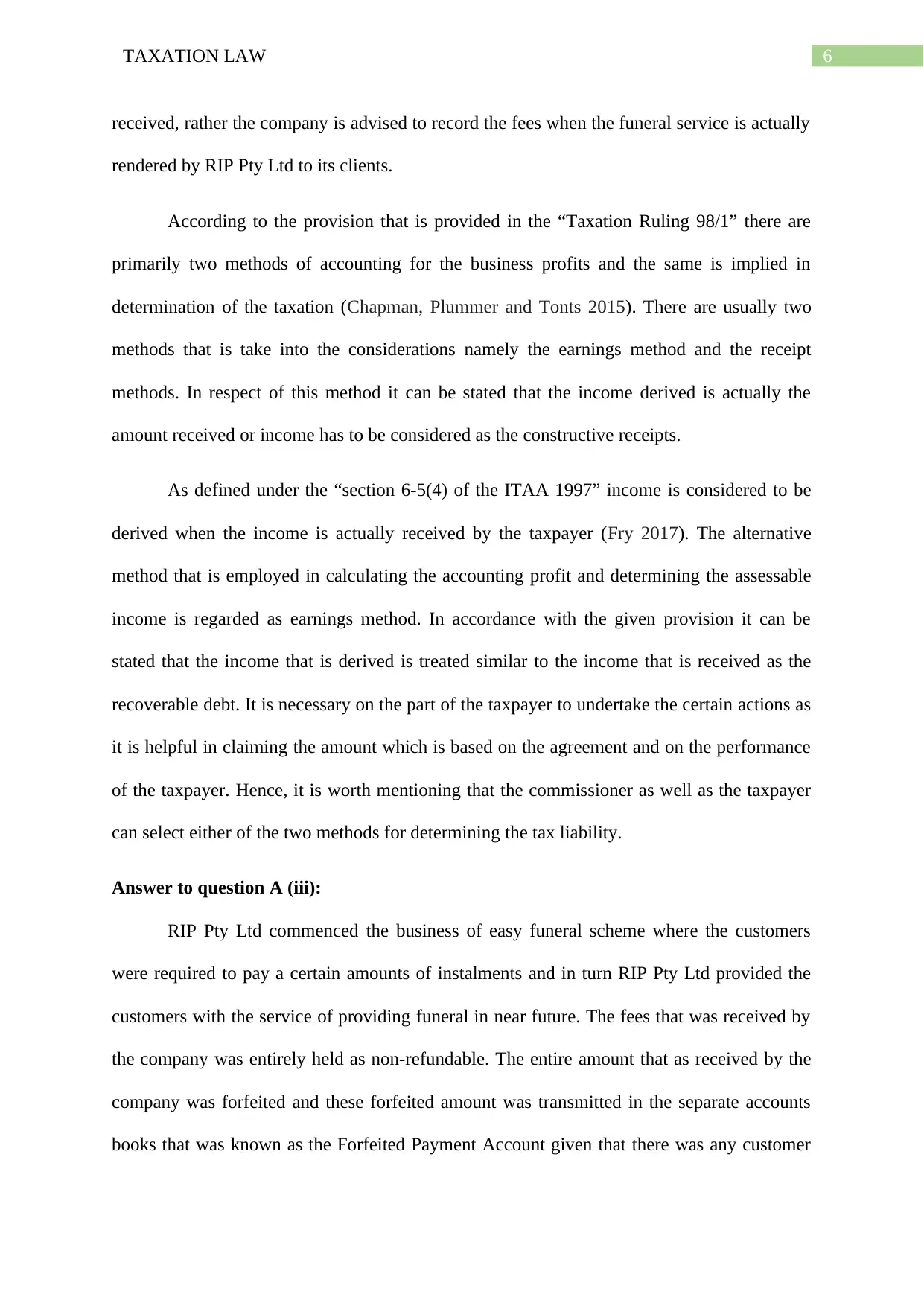
6TAXATION LAW
received, rather the company is advised to record the fees when the funeral service is actually
rendered by RIP Pty Ltd to its clients.
According to the provision that is provided in the “Taxation Ruling 98/1” there are
primarily two methods of accounting for the business profits and the same is implied in
determination of the taxation (Chapman, Plummer and Tonts 2015). There are usually two
methods that is take into the considerations namely the earnings method and the receipt
methods. In respect of this method it can be stated that the income derived is actually the
amount received or income has to be considered as the constructive receipts.
As defined under the “section 6-5(4) of the ITAA 1997” income is considered to be
derived when the income is actually received by the taxpayer (Fry 2017). The alternative
method that is employed in calculating the accounting profit and determining the assessable
income is regarded as earnings method. In accordance with the given provision it can be
stated that the income that is derived is treated similar to the income that is received as the
recoverable debt. It is necessary on the part of the taxpayer to undertake the certain actions as
it is helpful in claiming the amount which is based on the agreement and on the performance
of the taxpayer. Hence, it is worth mentioning that the commissioner as well as the taxpayer
can select either of the two methods for determining the tax liability.
Answer to question A (iii):
RIP Pty Ltd commenced the business of easy funeral scheme where the customers
were required to pay a certain amounts of instalments and in turn RIP Pty Ltd provided the
customers with the service of providing funeral in near future. The fees that was received by
the company was entirely held as non-refundable. The entire amount that as received by the
company was forfeited and these forfeited amount was transmitted in the separate accounts
books that was known as the Forfeited Payment Account given that there was any customer
received, rather the company is advised to record the fees when the funeral service is actually
rendered by RIP Pty Ltd to its clients.
According to the provision that is provided in the “Taxation Ruling 98/1” there are
primarily two methods of accounting for the business profits and the same is implied in
determination of the taxation (Chapman, Plummer and Tonts 2015). There are usually two
methods that is take into the considerations namely the earnings method and the receipt
methods. In respect of this method it can be stated that the income derived is actually the
amount received or income has to be considered as the constructive receipts.
As defined under the “section 6-5(4) of the ITAA 1997” income is considered to be
derived when the income is actually received by the taxpayer (Fry 2017). The alternative
method that is employed in calculating the accounting profit and determining the assessable
income is regarded as earnings method. In accordance with the given provision it can be
stated that the income that is derived is treated similar to the income that is received as the
recoverable debt. It is necessary on the part of the taxpayer to undertake the certain actions as
it is helpful in claiming the amount which is based on the agreement and on the performance
of the taxpayer. Hence, it is worth mentioning that the commissioner as well as the taxpayer
can select either of the two methods for determining the tax liability.
Answer to question A (iii):
RIP Pty Ltd commenced the business of easy funeral scheme where the customers
were required to pay a certain amounts of instalments and in turn RIP Pty Ltd provided the
customers with the service of providing funeral in near future. The fees that was received by
the company was entirely held as non-refundable. The entire amount that as received by the
company was forfeited and these forfeited amount was transmitted in the separate accounts
books that was known as the Forfeited Payment Account given that there was any customer
Paraphrase This Document
Need a fresh take? Get an instant paraphrase of this document with our AI Paraphraser
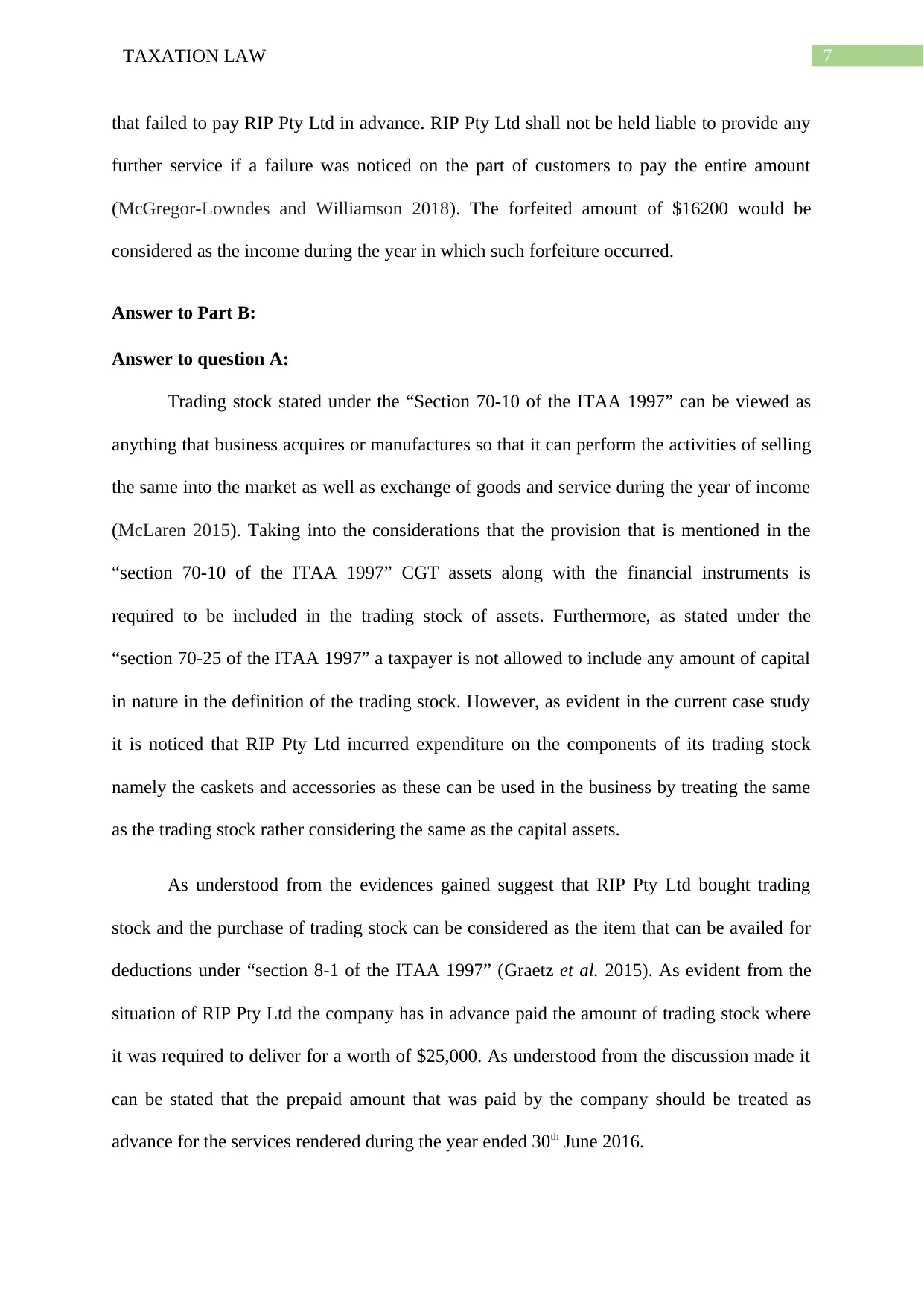
7TAXATION LAW
that failed to pay RIP Pty Ltd in advance. RIP Pty Ltd shall not be held liable to provide any
further service if a failure was noticed on the part of customers to pay the entire amount
(McGregor-Lowndes and Williamson 2018). The forfeited amount of $16200 would be
considered as the income during the year in which such forfeiture occurred.
Answer to Part B:
Answer to question A:
Trading stock stated under the “Section 70-10 of the ITAA 1997” can be viewed as
anything that business acquires or manufactures so that it can perform the activities of selling
the same into the market as well as exchange of goods and service during the year of income
(McLaren 2015). Taking into the considerations that the provision that is mentioned in the
“section 70-10 of the ITAA 1997” CGT assets along with the financial instruments is
required to be included in the trading stock of assets. Furthermore, as stated under the
“section 70-25 of the ITAA 1997” a taxpayer is not allowed to include any amount of capital
in nature in the definition of the trading stock. However, as evident in the current case study
it is noticed that RIP Pty Ltd incurred expenditure on the components of its trading stock
namely the caskets and accessories as these can be used in the business by treating the same
as the trading stock rather considering the same as the capital assets.
As understood from the evidences gained suggest that RIP Pty Ltd bought trading
stock and the purchase of trading stock can be considered as the item that can be availed for
deductions under “section 8-1 of the ITAA 1997” (Graetz et al. 2015). As evident from the
situation of RIP Pty Ltd the company has in advance paid the amount of trading stock where
it was required to deliver for a worth of $25,000. As understood from the discussion made it
can be stated that the prepaid amount that was paid by the company should be treated as
advance for the services rendered during the year ended 30th June 2016.
that failed to pay RIP Pty Ltd in advance. RIP Pty Ltd shall not be held liable to provide any
further service if a failure was noticed on the part of customers to pay the entire amount
(McGregor-Lowndes and Williamson 2018). The forfeited amount of $16200 would be
considered as the income during the year in which such forfeiture occurred.
Answer to Part B:
Answer to question A:
Trading stock stated under the “Section 70-10 of the ITAA 1997” can be viewed as
anything that business acquires or manufactures so that it can perform the activities of selling
the same into the market as well as exchange of goods and service during the year of income
(McLaren 2015). Taking into the considerations that the provision that is mentioned in the
“section 70-10 of the ITAA 1997” CGT assets along with the financial instruments is
required to be included in the trading stock of assets. Furthermore, as stated under the
“section 70-25 of the ITAA 1997” a taxpayer is not allowed to include any amount of capital
in nature in the definition of the trading stock. However, as evident in the current case study
it is noticed that RIP Pty Ltd incurred expenditure on the components of its trading stock
namely the caskets and accessories as these can be used in the business by treating the same
as the trading stock rather considering the same as the capital assets.
As understood from the evidences gained suggest that RIP Pty Ltd bought trading
stock and the purchase of trading stock can be considered as the item that can be availed for
deductions under “section 8-1 of the ITAA 1997” (Graetz et al. 2015). As evident from the
situation of RIP Pty Ltd the company has in advance paid the amount of trading stock where
it was required to deliver for a worth of $25,000. As understood from the discussion made it
can be stated that the prepaid amount that was paid by the company should be treated as
advance for the services rendered during the year ended 30th June 2016.
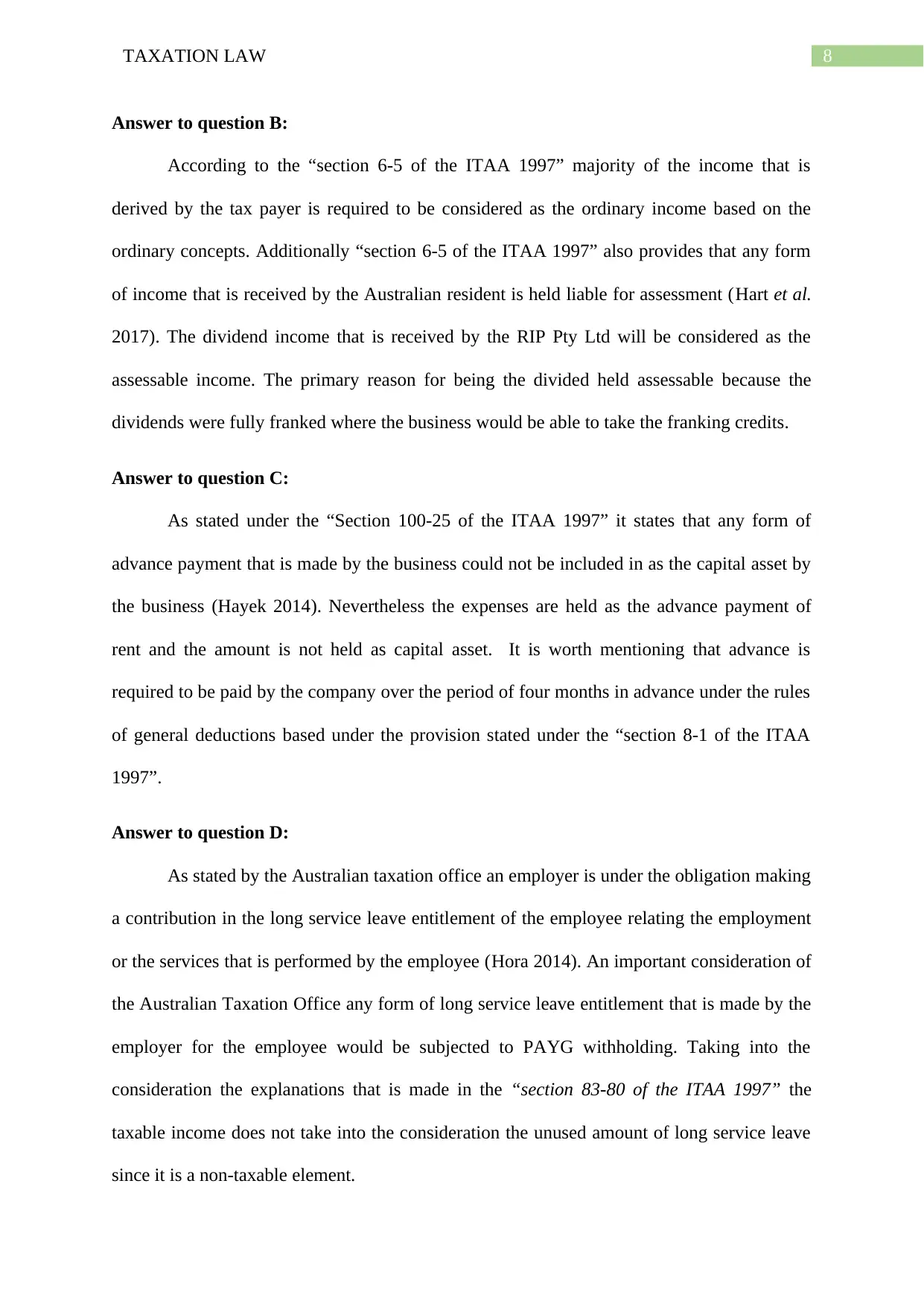
8TAXATION LAW
Answer to question B:
According to the “section 6-5 of the ITAA 1997” majority of the income that is
derived by the tax payer is required to be considered as the ordinary income based on the
ordinary concepts. Additionally “section 6-5 of the ITAA 1997” also provides that any form
of income that is received by the Australian resident is held liable for assessment (Hart et al.
2017). The dividend income that is received by the RIP Pty Ltd will be considered as the
assessable income. The primary reason for being the divided held assessable because the
dividends were fully franked where the business would be able to take the franking credits.
Answer to question C:
As stated under the “Section 100-25 of the ITAA 1997” it states that any form of
advance payment that is made by the business could not be included in as the capital asset by
the business (Hayek 2014). Nevertheless the expenses are held as the advance payment of
rent and the amount is not held as capital asset. It is worth mentioning that advance is
required to be paid by the company over the period of four months in advance under the rules
of general deductions based under the provision stated under the “section 8-1 of the ITAA
1997”.
Answer to question D:
As stated by the Australian taxation office an employer is under the obligation making
a contribution in the long service leave entitlement of the employee relating the employment
or the services that is performed by the employee (Hora 2014). An important consideration of
the Australian Taxation Office any form of long service leave entitlement that is made by the
employer for the employee would be subjected to PAYG withholding. Taking into the
consideration the explanations that is made in the “section 83-80 of the ITAA 1997” the
taxable income does not take into the consideration the unused amount of long service leave
since it is a non-taxable element.
Answer to question B:
According to the “section 6-5 of the ITAA 1997” majority of the income that is
derived by the tax payer is required to be considered as the ordinary income based on the
ordinary concepts. Additionally “section 6-5 of the ITAA 1997” also provides that any form
of income that is received by the Australian resident is held liable for assessment (Hart et al.
2017). The dividend income that is received by the RIP Pty Ltd will be considered as the
assessable income. The primary reason for being the divided held assessable because the
dividends were fully franked where the business would be able to take the franking credits.
Answer to question C:
As stated under the “Section 100-25 of the ITAA 1997” it states that any form of
advance payment that is made by the business could not be included in as the capital asset by
the business (Hayek 2014). Nevertheless the expenses are held as the advance payment of
rent and the amount is not held as capital asset. It is worth mentioning that advance is
required to be paid by the company over the period of four months in advance under the rules
of general deductions based under the provision stated under the “section 8-1 of the ITAA
1997”.
Answer to question D:
As stated by the Australian taxation office an employer is under the obligation making
a contribution in the long service leave entitlement of the employee relating the employment
or the services that is performed by the employee (Hora 2014). An important consideration of
the Australian Taxation Office any form of long service leave entitlement that is made by the
employer for the employee would be subjected to PAYG withholding. Taking into the
consideration the explanations that is made in the “section 83-80 of the ITAA 1997” the
taxable income does not take into the consideration the unused amount of long service leave
since it is a non-taxable element.
⊘ This is a preview!⊘
Do you want full access?
Subscribe today to unlock all pages.

Trusted by 1+ million students worldwide
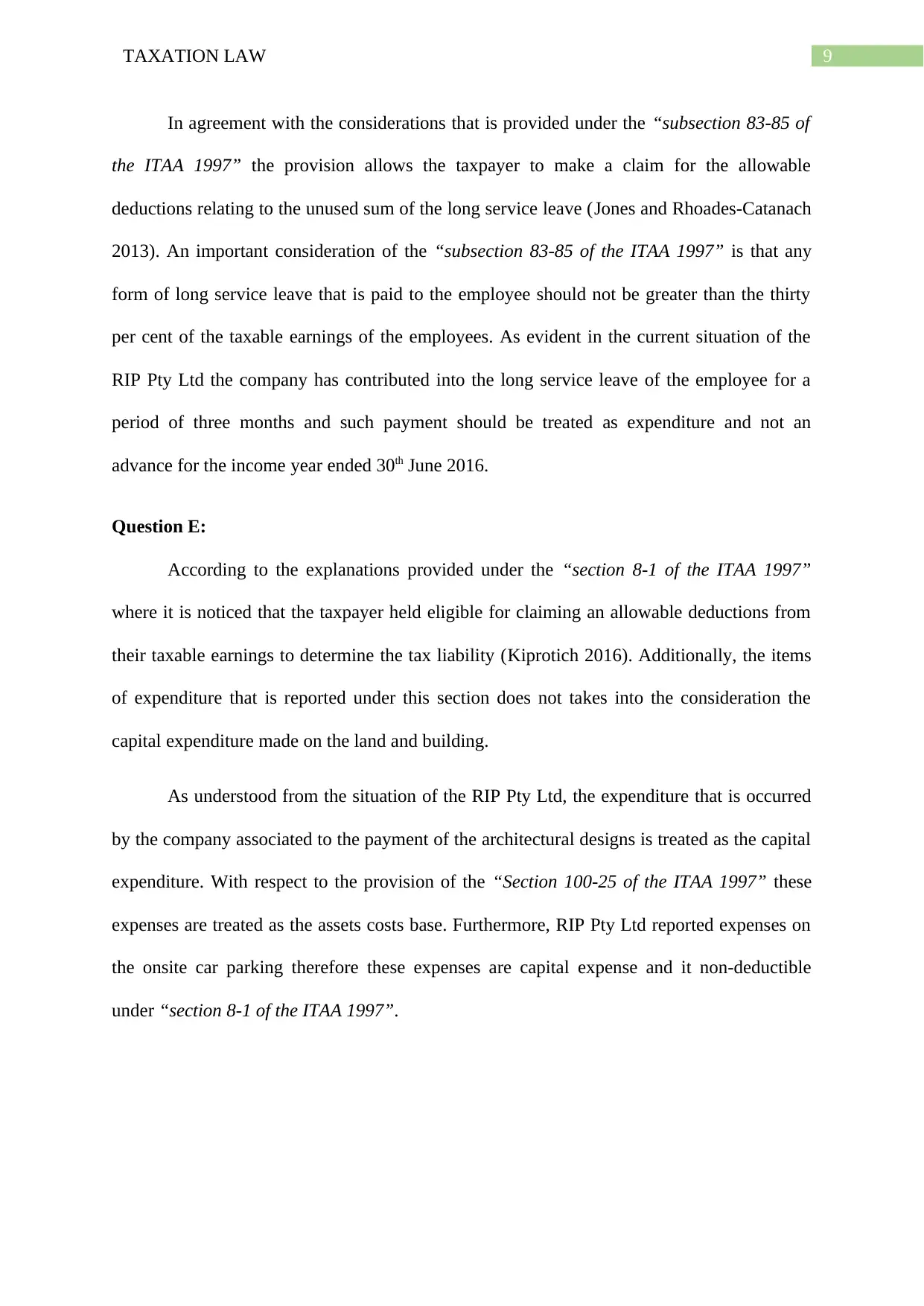
9TAXATION LAW
In agreement with the considerations that is provided under the “subsection 83-85 of
the ITAA 1997” the provision allows the taxpayer to make a claim for the allowable
deductions relating to the unused sum of the long service leave (Jones and Rhoades-Catanach
2013). An important consideration of the “subsection 83-85 of the ITAA 1997” is that any
form of long service leave that is paid to the employee should not be greater than the thirty
per cent of the taxable earnings of the employees. As evident in the current situation of the
RIP Pty Ltd the company has contributed into the long service leave of the employee for a
period of three months and such payment should be treated as expenditure and not an
advance for the income year ended 30th June 2016.
Question E:
According to the explanations provided under the “section 8-1 of the ITAA 1997”
where it is noticed that the taxpayer held eligible for claiming an allowable deductions from
their taxable earnings to determine the tax liability (Kiprotich 2016). Additionally, the items
of expenditure that is reported under this section does not takes into the consideration the
capital expenditure made on the land and building.
As understood from the situation of the RIP Pty Ltd, the expenditure that is occurred
by the company associated to the payment of the architectural designs is treated as the capital
expenditure. With respect to the provision of the “Section 100-25 of the ITAA 1997” these
expenses are treated as the assets costs base. Furthermore, RIP Pty Ltd reported expenses on
the onsite car parking therefore these expenses are capital expense and it non-deductible
under “section 8-1 of the ITAA 1997”.
In agreement with the considerations that is provided under the “subsection 83-85 of
the ITAA 1997” the provision allows the taxpayer to make a claim for the allowable
deductions relating to the unused sum of the long service leave (Jones and Rhoades-Catanach
2013). An important consideration of the “subsection 83-85 of the ITAA 1997” is that any
form of long service leave that is paid to the employee should not be greater than the thirty
per cent of the taxable earnings of the employees. As evident in the current situation of the
RIP Pty Ltd the company has contributed into the long service leave of the employee for a
period of three months and such payment should be treated as expenditure and not an
advance for the income year ended 30th June 2016.
Question E:
According to the explanations provided under the “section 8-1 of the ITAA 1997”
where it is noticed that the taxpayer held eligible for claiming an allowable deductions from
their taxable earnings to determine the tax liability (Kiprotich 2016). Additionally, the items
of expenditure that is reported under this section does not takes into the consideration the
capital expenditure made on the land and building.
As understood from the situation of the RIP Pty Ltd, the expenditure that is occurred
by the company associated to the payment of the architectural designs is treated as the capital
expenditure. With respect to the provision of the “Section 100-25 of the ITAA 1997” these
expenses are treated as the assets costs base. Furthermore, RIP Pty Ltd reported expenses on
the onsite car parking therefore these expenses are capital expense and it non-deductible
under “section 8-1 of the ITAA 1997”.
Paraphrase This Document
Need a fresh take? Get an instant paraphrase of this document with our AI Paraphraser
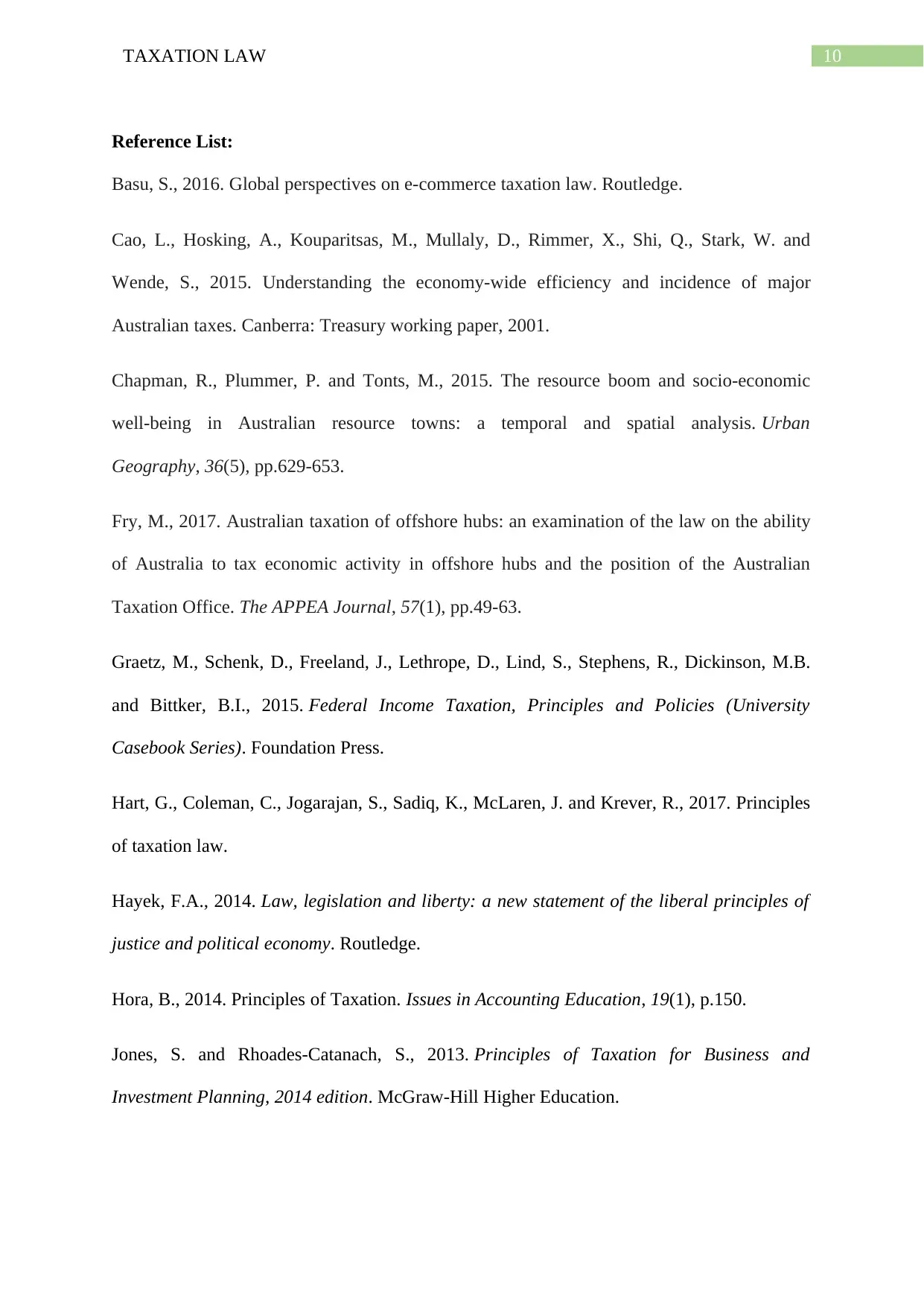
10TAXATION LAW
Reference List:
Basu, S., 2016. Global perspectives on e-commerce taxation law. Routledge.
Cao, L., Hosking, A., Kouparitsas, M., Mullaly, D., Rimmer, X., Shi, Q., Stark, W. and
Wende, S., 2015. Understanding the economy-wide efficiency and incidence of major
Australian taxes. Canberra: Treasury working paper, 2001.
Chapman, R., Plummer, P. and Tonts, M., 2015. The resource boom and socio-economic
well-being in Australian resource towns: a temporal and spatial analysis. Urban
Geography, 36(5), pp.629-653.
Fry, M., 2017. Australian taxation of offshore hubs: an examination of the law on the ability
of Australia to tax economic activity in offshore hubs and the position of the Australian
Taxation Office. The APPEA Journal, 57(1), pp.49-63.
Graetz, M., Schenk, D., Freeland, J., Lethrope, D., Lind, S., Stephens, R., Dickinson, M.B.
and Bittker, B.I., 2015. Federal Income Taxation, Principles and Policies (University
Casebook Series). Foundation Press.
Hart, G., Coleman, C., Jogarajan, S., Sadiq, K., McLaren, J. and Krever, R., 2017. Principles
of taxation law.
Hayek, F.A., 2014. Law, legislation and liberty: a new statement of the liberal principles of
justice and political economy. Routledge.
Hora, B., 2014. Principles of Taxation. Issues in Accounting Education, 19(1), p.150.
Jones, S. and Rhoades-Catanach, S., 2013. Principles of Taxation for Business and
Investment Planning, 2014 edition. McGraw-Hill Higher Education.
Reference List:
Basu, S., 2016. Global perspectives on e-commerce taxation law. Routledge.
Cao, L., Hosking, A., Kouparitsas, M., Mullaly, D., Rimmer, X., Shi, Q., Stark, W. and
Wende, S., 2015. Understanding the economy-wide efficiency and incidence of major
Australian taxes. Canberra: Treasury working paper, 2001.
Chapman, R., Plummer, P. and Tonts, M., 2015. The resource boom and socio-economic
well-being in Australian resource towns: a temporal and spatial analysis. Urban
Geography, 36(5), pp.629-653.
Fry, M., 2017. Australian taxation of offshore hubs: an examination of the law on the ability
of Australia to tax economic activity in offshore hubs and the position of the Australian
Taxation Office. The APPEA Journal, 57(1), pp.49-63.
Graetz, M., Schenk, D., Freeland, J., Lethrope, D., Lind, S., Stephens, R., Dickinson, M.B.
and Bittker, B.I., 2015. Federal Income Taxation, Principles and Policies (University
Casebook Series). Foundation Press.
Hart, G., Coleman, C., Jogarajan, S., Sadiq, K., McLaren, J. and Krever, R., 2017. Principles
of taxation law.
Hayek, F.A., 2014. Law, legislation and liberty: a new statement of the liberal principles of
justice and political economy. Routledge.
Hora, B., 2014. Principles of Taxation. Issues in Accounting Education, 19(1), p.150.
Jones, S. and Rhoades-Catanach, S., 2013. Principles of Taxation for Business and
Investment Planning, 2014 edition. McGraw-Hill Higher Education.
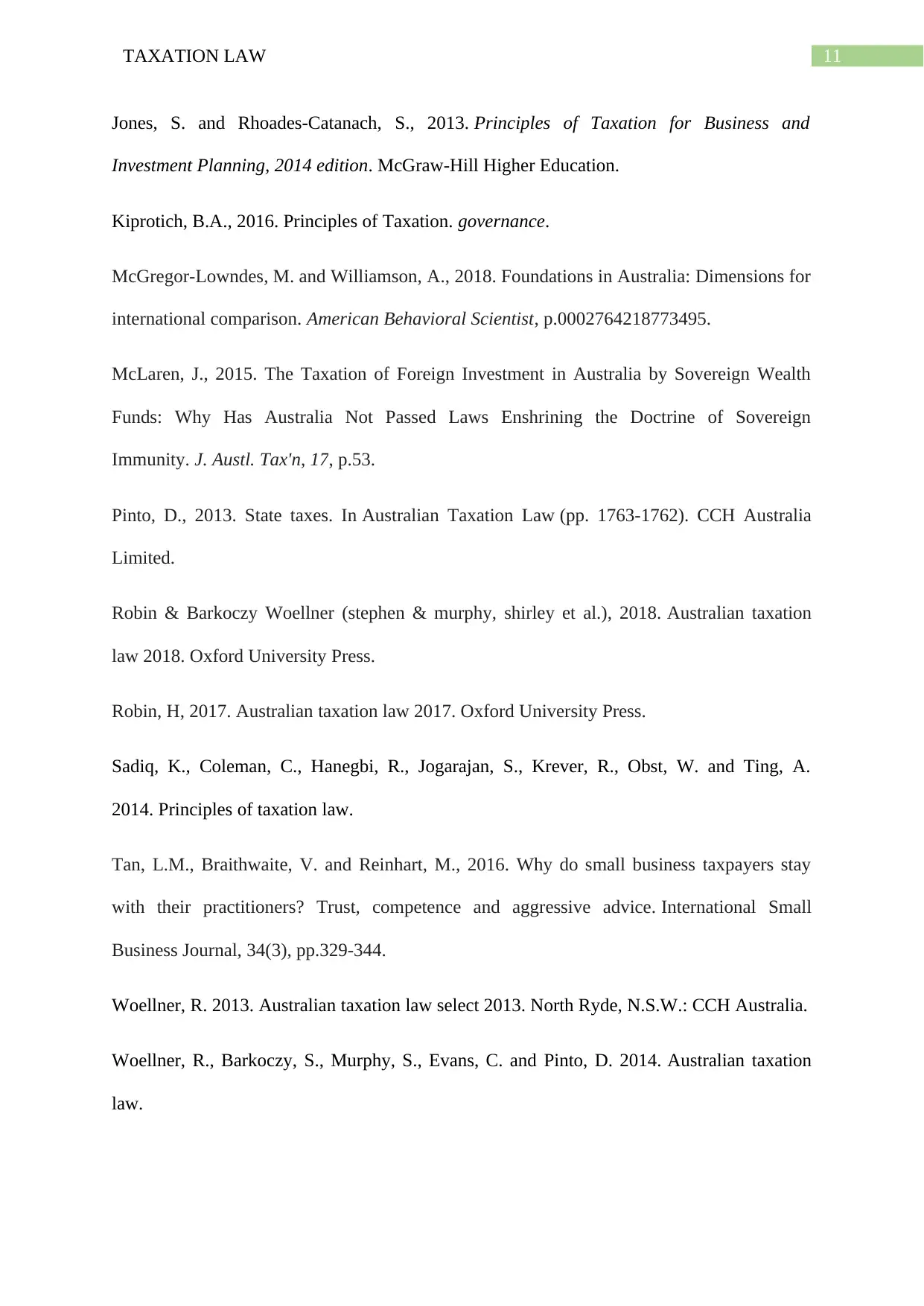
11TAXATION LAW
Jones, S. and Rhoades-Catanach, S., 2013. Principles of Taxation for Business and
Investment Planning, 2014 edition. McGraw-Hill Higher Education.
Kiprotich, B.A., 2016. Principles of Taxation. governance.
McGregor-Lowndes, M. and Williamson, A., 2018. Foundations in Australia: Dimensions for
international comparison. American Behavioral Scientist, p.0002764218773495.
McLaren, J., 2015. The Taxation of Foreign Investment in Australia by Sovereign Wealth
Funds: Why Has Australia Not Passed Laws Enshrining the Doctrine of Sovereign
Immunity. J. Austl. Tax'n, 17, p.53.
Pinto, D., 2013. State taxes. In Australian Taxation Law (pp. 1763-1762). CCH Australia
Limited.
Robin & Barkoczy Woellner (stephen & murphy, shirley et al.), 2018. Australian taxation
law 2018. Oxford University Press.
Robin, H, 2017. Australian taxation law 2017. Oxford University Press.
Sadiq, K., Coleman, C., Hanegbi, R., Jogarajan, S., Krever, R., Obst, W. and Ting, A.
2014. Principles of taxation law.
Tan, L.M., Braithwaite, V. and Reinhart, M., 2016. Why do small business taxpayers stay
with their practitioners? Trust, competence and aggressive advice. International Small
Business Journal, 34(3), pp.329-344.
Woellner, R. 2013. Australian taxation law select 2013. North Ryde, N.S.W.: CCH Australia.
Woellner, R., Barkoczy, S., Murphy, S., Evans, C. and Pinto, D. 2014. Australian taxation
law.
Jones, S. and Rhoades-Catanach, S., 2013. Principles of Taxation for Business and
Investment Planning, 2014 edition. McGraw-Hill Higher Education.
Kiprotich, B.A., 2016. Principles of Taxation. governance.
McGregor-Lowndes, M. and Williamson, A., 2018. Foundations in Australia: Dimensions for
international comparison. American Behavioral Scientist, p.0002764218773495.
McLaren, J., 2015. The Taxation of Foreign Investment in Australia by Sovereign Wealth
Funds: Why Has Australia Not Passed Laws Enshrining the Doctrine of Sovereign
Immunity. J. Austl. Tax'n, 17, p.53.
Pinto, D., 2013. State taxes. In Australian Taxation Law (pp. 1763-1762). CCH Australia
Limited.
Robin & Barkoczy Woellner (stephen & murphy, shirley et al.), 2018. Australian taxation
law 2018. Oxford University Press.
Robin, H, 2017. Australian taxation law 2017. Oxford University Press.
Sadiq, K., Coleman, C., Hanegbi, R., Jogarajan, S., Krever, R., Obst, W. and Ting, A.
2014. Principles of taxation law.
Tan, L.M., Braithwaite, V. and Reinhart, M., 2016. Why do small business taxpayers stay
with their practitioners? Trust, competence and aggressive advice. International Small
Business Journal, 34(3), pp.329-344.
Woellner, R. 2013. Australian taxation law select 2013. North Ryde, N.S.W.: CCH Australia.
Woellner, R., Barkoczy, S., Murphy, S., Evans, C. and Pinto, D. 2014. Australian taxation
law.
⊘ This is a preview!⊘
Do you want full access?
Subscribe today to unlock all pages.

Trusted by 1+ million students worldwide
1 out of 13
Related Documents
Your All-in-One AI-Powered Toolkit for Academic Success.
+13062052269
info@desklib.com
Available 24*7 on WhatsApp / Email
![[object Object]](/_next/static/media/star-bottom.7253800d.svg)
Unlock your academic potential
Copyright © 2020–2025 A2Z Services. All Rights Reserved. Developed and managed by ZUCOL.





